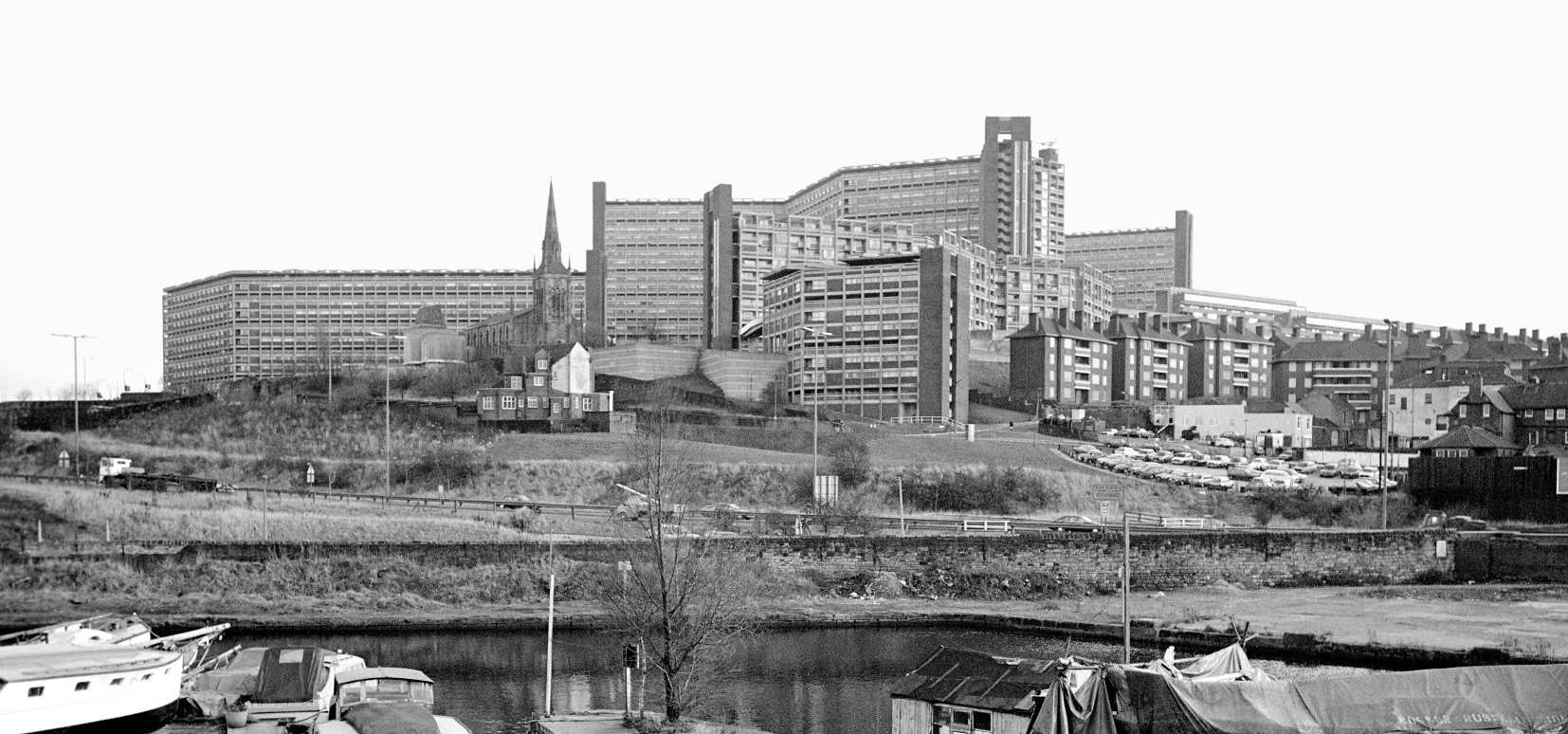
[HP i] Hyde Park and Park Hill flats Sheffield taken from Victoria Quays with the Sheffield and Tinsley canal and Tulley’s Boat Yard in the foreground. March 1988
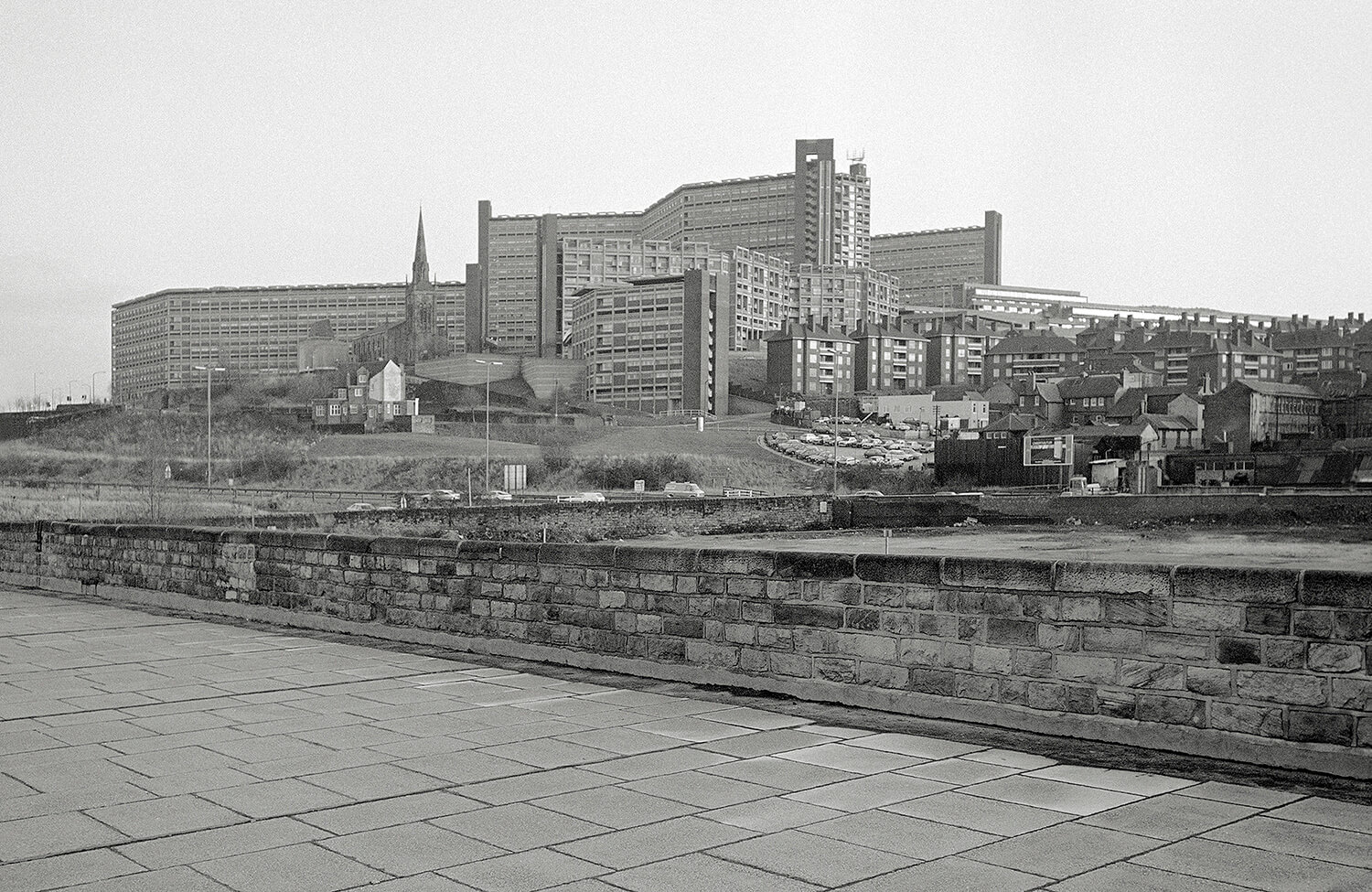
[HP ii] View from South Street
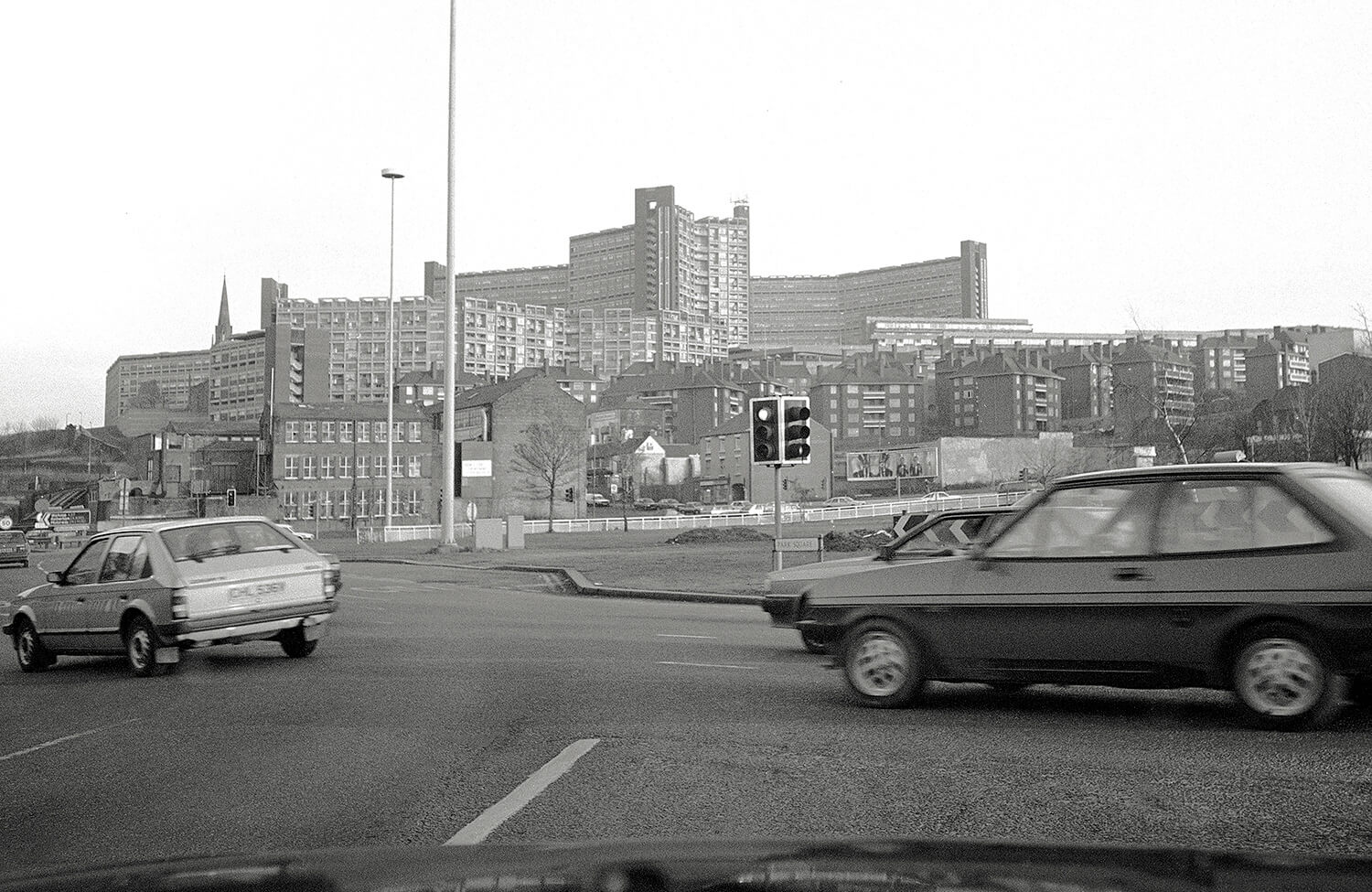
[HP iii] View from the Park Square roundabout
‘Streets in the Sky’
Portraits of the last tenants at Hyde Park Flats, Sheffield 1988.
History and Construction
Built on one of Sheffield’s reputed seven hills, the monumental council housing developments of Park Hill and Hyde Park were divided into two distinct areas; the low rise Park Hill flats and the high-rise tower blocks of Hyde Park. My purpose was to photograph and therefore record the last community of social housing tenants living at the high rise Hyde Park flats in 1988 before being vacated during 1989-90 to provide accommodation for competitors at the 1991 World Student Games. Hyde Park was finally demolished between 1992-3, a landmark building that had dominated Sheffield’s skyline for over twenty years.
Post-war optimism, civic pride and the urgent need to improve the quality of council housing to accommodate Sheffield’s growing working class population produced Europe’s largest ever social housing development.
Commissioned by J L Womersely, Sheffield’s Chief Architect between 1953-64, his vision for the development was influenced by the modernist design philosophy of Swiss architect Le Corbusier. He appointed principle architects Jack Lynn and Ivor Smith who despite having just graduated from university were both advocates of ‘Modernism’ and ‘Brutalism.’ They began preliminary design work on the Park Hill and Hyde Park developments in 1953 believing that modernist architecture could preserve and even enhance a sense of social and communal cohesion.
A viability survey was completed in 1955 by Sheffield City Council concluded that the site;
“…was suitable for high density, multi-storey housing due to the proximity of the city centre, geological stability, clean air as the site was located on the leeward side away from the heavy industrial pollution of the Don Valley, open topography, ample light and magnificent views.”
Construction started at Park Hill in 1957 and was completed in 1961, followed by Hyde Park in 1965 which was opened by the Queen Mother in June 1966.
The site to be redeveloped was one of the earliest large scale slum clearances of poor quality, dilapidated and insanitary back-to-back and courtyard housing in Britain. Having originally built to accommodate the rapid influx of workers employed in the steel industry during the 19th century. It had been previously known as ‘Little Chicago’ in the 1920’s and 30’s due to its reputation for overcrowding, poverty and violent crime, the area was partly demolished in the late 1930’s and late 1940’s much of the housing being condemned as unfit for human habitation.
In order to replace the number of houses lost through redevelopment, it was decided that only a multi-storey development on that site would be possible. At 18 storeys Hyde Park flats were the highest outside London with the entire scheme consisted of 665 flats and 648 maisonettes housing up to 4,600 people. Included in the design was a Garchey waste disposal system, a junior and infants school, shops, 4 pubs, a youth club and children’s play area, a clinic and launderette.
Described as resembling a citadel or medieval Italian hill village, the design was considered revolutionary at the time as access to the flats was provided by decks that were open to the elements, yet wide enough to allow children to play safely outdoors and neighbours to interact with each other, small electric vehicles such as milk floats were also able to service the flats. Former street names were reused with the word ‘street’ being supplanted by ‘row’. Both estates were highly praised at the time in the belief that community life could be maintained by following principles of the 19th century terraced housing they replaced.
‘Streets in the Sky’ was the architectural term derived from these wide open decks. It was initially popular and successful, but was later marred by inadequate maintenance which contributed to the decaying fabric of the building, poor security and the allocation of flats to unsuitable tenants. By the mid 1980’s the City Council considered the flats to be unviable and were a failed experiment in multi-storey social housing.
The remaining Park Hill estate today is part private and part council housing and is currently undergoing refurbishment, it was listed Grade II* in 1998, making it the largest protected building in Europe.
My Work
When I read in the Sheffield Star newspaper that Hyde Park flats were scheduled to be demolished I decided together with Matthew Conduit manager of the Untitled Gallery, (now Site Gallery), Sheffield, that some sort of photographic documentation should be made to record this iconic building before its destruction.
I had not been a resident at Hyde Park flats, so before starting the project I had expected to photograph tenants alienated in an ‘Orwellian, lawless, dystopian concrete jungle’ and could not wait to be rehoused. However, this populist opinion of the flats seemed to have been made by ill informed people who disliked brutalist architecture and had never lived at the flats. Regrettably, I went along with this narrative for some time producing dislocated, impersonal, ‘street style’ photography, uncertain whether the architecture or the residents should dominate the image.
After some time I realised this approach was completely wrong, so I stopped taking photographs and started talking to the tenants, attending meetings and attempted to become a ‘guest’ in their community in order to reflect ‘with some truth’ what I found.
I restarted the project and began taking photographs with the emphasis being on the residents and less so on the architecture which now became an incidental backdrop to the portraits. I also decided to try and look less like an outsider or an official and therefore less conspicuous, so while walking around the estate I kept my camera in a supermarket plastic carrier bag.
During the late spring and summer of 1988 I became a recognised character on the estate and developed a familiarity and intimacy with the residents which I hope comes across in the portraits. As I got to know the residents, kids would often shout from the balconies;
“Bill, have you taken any good photos today?”
Very quickly I found a close-knit, welcoming, multicultural community that did not want to be dispersed throughout the various social housing estates on the outskirts of Sheffield. Regardless of the current run down condition of the flats in 1988 I didn’t meet a single resident who wanted to be rehoused. They considered Hyde Park to be their home, a special place to live and were proud to be social housing tenants living in such a prominent building that overlooked Sheffield.
Despite its current shortcomings, many tenants believed Hyde Park represented a vision for social housing that was both optimistic and outward looking and that the council had made ill judged and politically motivated decisions which contributed to Hyde Park’s decline, deterioration and eventual demolition.
Some tenants expressed their opinion that the dispossession of their homes and the demolition of Hyde Park was a politically driven decision by the Conservative Thatcher government to remove tenants out of social housing and into the private housing sector. They believed they were victims of ’social engineering’ which was part of a government policy to abdicate social responsibility making people less dependant on the state and more self-reliant.
However, the principle reason for Hyde Park’s demise is inevitably linked to collapse of the steel industry during the early 1980’s, which produced high unemployment and a bankrupt city council. Nevertheless tenants felt that the decision to run down the building making it almost uninhabitable, such as the slow repair of the lifts and removal of graffiti added to the stress and uncertainty of where they were going to be relocated to.
Many felt that such a unique and celebrated building should have been refurbished and allowed to evolve and develop over time, rather than be demolished. However no consultation was made by the council and the residents opinions were not taken into consideration.
My thanks go the tenants that supported and enabled my photography at Hyde Park flats in 1988 and it’s testament to the strength of that community that it still thrives through social media 35 years later.
The original project and exhibition was supported by Matthew Conduit, curator and manager at the Untitled Gallery, Sheffield and financially by Sir Norman Adsetts OBE, Yorkshire Arts and MasterLab.
‘Streets in the Sky‘ was nominated for the Fox Talbot Award in 1989 by the National Museum for Photography, Film and Television, Bradford.
All images are Strictly Copyright © Bill Stephenson All Rights Reserved.
Streets in the Sky – book & print sales
Portraits of the last residents at Hyde Park Flats, Sheffield, 1988
Book:
Foreword by writer, broadcaster and photographer Johny Pitts
Signed, softcover, 94 pages, 43 photographs, 210mm x 210mm
Published by Revelations 23 Press
Prints:
Archival quality prints are available at the following sizes:
- 8″x 8″ (203mm x 203mm)
- 12″x 12″ (304mm x 304mm)
- 20″x 20″ (504mm x504mm)
Colours in Concrete
Colours in Concrete is an essay written by Sheffield born Johny Pitts in response the Streets in the Sky photographs.
Johny is a broadcaster, writer and photography and is the author of Afropean:Notes from Black Europe which won the 2020 Jhalak Prize, the 2020 Bread and Roses Award and the 2021 Leipzig Book Award for European Understanding.
Colours in Concrete is included in the Streets in the Sky book.
Selected exhibitions and imagery generated from ‘Streets in the Sky’
‘Love Among the Ruins: A Romance of the Near Future’
In 2018 a re-interpretation of the 1988 exhibition ‘Streets in Sky’ originally shown at the Untitled Gallery, Sheffield was selected as the inaugural exhibition at the newly constructed S1 Artspace, Park Hill, Sheffield. ‘Love Among the Ruins’ was curated by Laura Clarke and featured previously unseen work from myself and the late Roger Mayne.
The exhibition takes its title from Evelyn Waugh’s satirical short story which imagines a dystopian future Britain as the result of an overbearing welfare state. Written in 1953 Waugh’s story foreshadowed some of the concerns about the possible social consequences of the government’s progressive post-war approach to rebuilding the country.
‘Love Among the Ruins’ ran from 20th July -15th September 2018. The exhibition was both popular and critically successful with over 450 guests attending the preview, additionally the gallery welcomed 4041 visitors during its 28 exhibition days.
‘The People of Park Hill’
The original 1988 ‘Streets in Sky’ exhibition was again reinterpreted and exhibited at the Crucible Theatre, Sheffield, between 14th March – 6th April 2019, supporting Richard Hawley’s new musical ‘Standing At The Sky’s Edge’.
‘Standing At The Sky’s Edge’ written by Chris Bush, documents three generations of tenants; from the flats optimistic utopian beginnings, their dilapidation and later gentrification. Richard Hawley’s soundtrack reflects social change, nostalgia, faded dreams and new beginnings. The musical was a sellout for The Crucible, generating huge public interest and great reviews, extra performances having to be added to cope with demand.
The 35 photographs were presented as a slide loop on 5 4k 50″ monitors located in the theatre foyer and bar areas. Two large scale vinyl posters promoted the exhibition and musical, located at the theatre entrance.
This exhibition was supported by Urban Splash and vinyl posters design by MM Design Ltd.

Saint Raymond ‘Right Way Round’ EP and Video Promotion Image
In May 2020 an edited version of ‘Roller Skating Paper Girls’ [HP 002] was selected by Bee Happy Media, Manchester to promote singer/songwriter Saint Raymond’s latest EP ‘Right Way Round’.
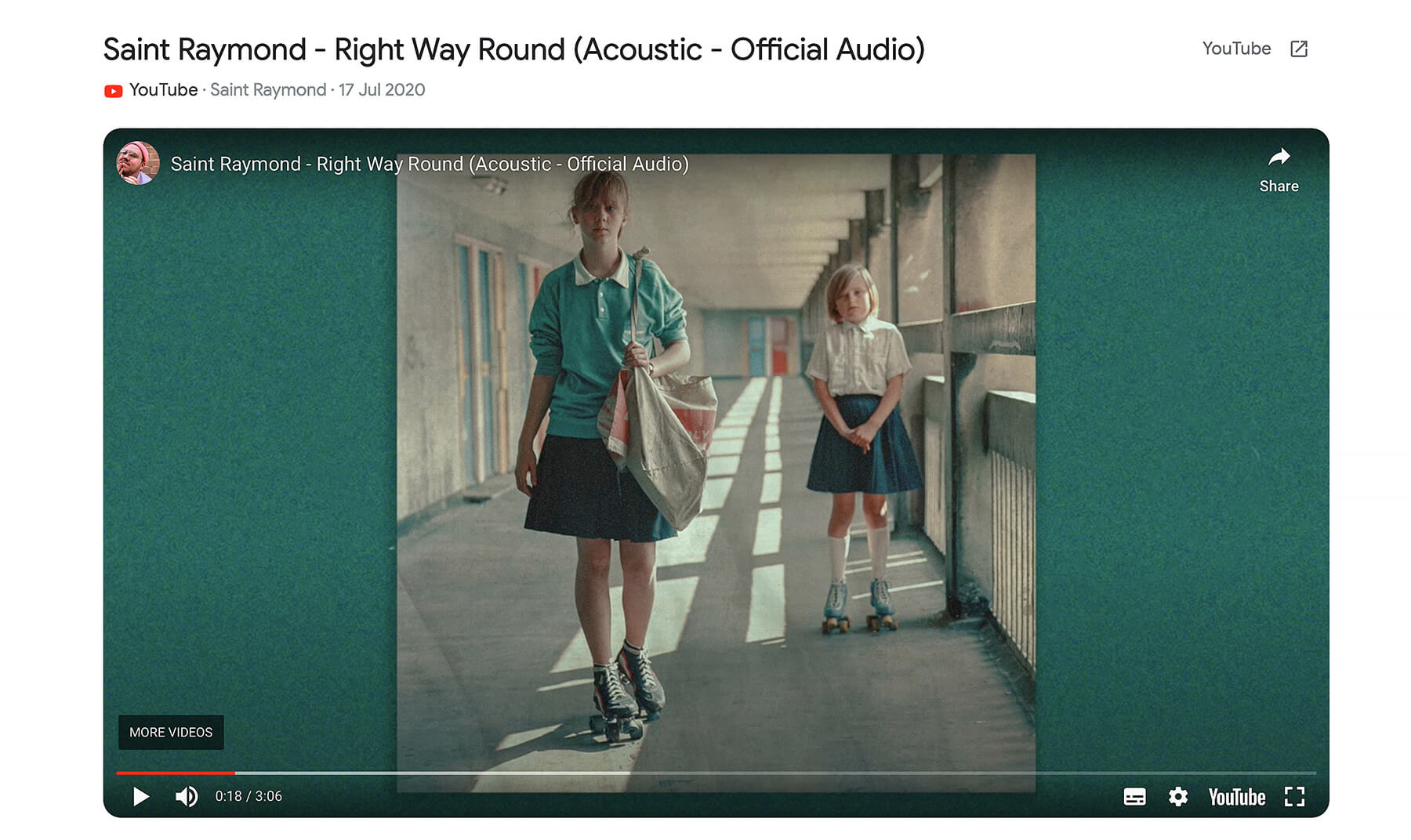

The Sheffield Project:
Photographs of a Changing City.
Weston Park Museum, Sheffield. Oct 2020 -May 2021
Photographs from ‘Streets in the Sky‘ featured prominently in this group exhibition, including the exhibition banner.
The exhibition documented a pivotal time in the cities history during the 1980’s. It was a time of great upheaval after the Miner’s Strike when the steel industry’s workforce was decimated contributing to mass unemployment and dereliction. However, it was also a time when the city looked forward to imagine another future of transformation and reconstruction.

Luke Una’s É Soul Cultura Album

This photograph of Hyde Park flats was licensed for the double inner gatefold photograph for Manchester dance and DJ legend Luke Una‘s best selling 2xLP É Soul Cultura.
Luke was a tenant at Hyde Park flats in the mid-1980’s, before becoming renowned in the Balearic, Brazilian E soul, house, disco and techno scene. He wanted to use an image of Hyde Park flats on his album as this was where his musical career and life started.
He describes this compilation album as “outer cosmos, transcendental music for the late night disenfranchised who are just holding it together”. It was nominated for the ‘Best of British’ compilation album 2022 and is available on the Mr Bongo record label.
É Soul Cultura Vol.2

The same photograph of Hyde Park Flats, Sheffield was used in the inner gatefold collage for Manchester DJ Luke Una‘s latest double album É Soul Cultura Vol.2.
He describes this compilation album as “…musical alchemy, unifying the diverse“.
It’s available from the Mr Bongo record label
The Black Dog Album Covers
and My Brutal Life Exhibition

This photograph of Mr Ackforth was used by Sheffield based musicians The Black Dog as the cover image for their new techno album, LP, CD and to promote their live AV set and the associated exhibition catalogue My Brutal Life.
My Brutal Life, “…explores the human side of artistic work inspired by brutalist architecture, its environments and people”.
Sensoria Music and Film Festival

This exhibition formed part of the Sensoria Music and Film Festival, October 2023. A selection of photographs from ‘Streets in the Sky‘ were exhibited at the iconic Moore Street Electricity Substation, Sheffield. This group AV exhibition was curated by Martin Dust.
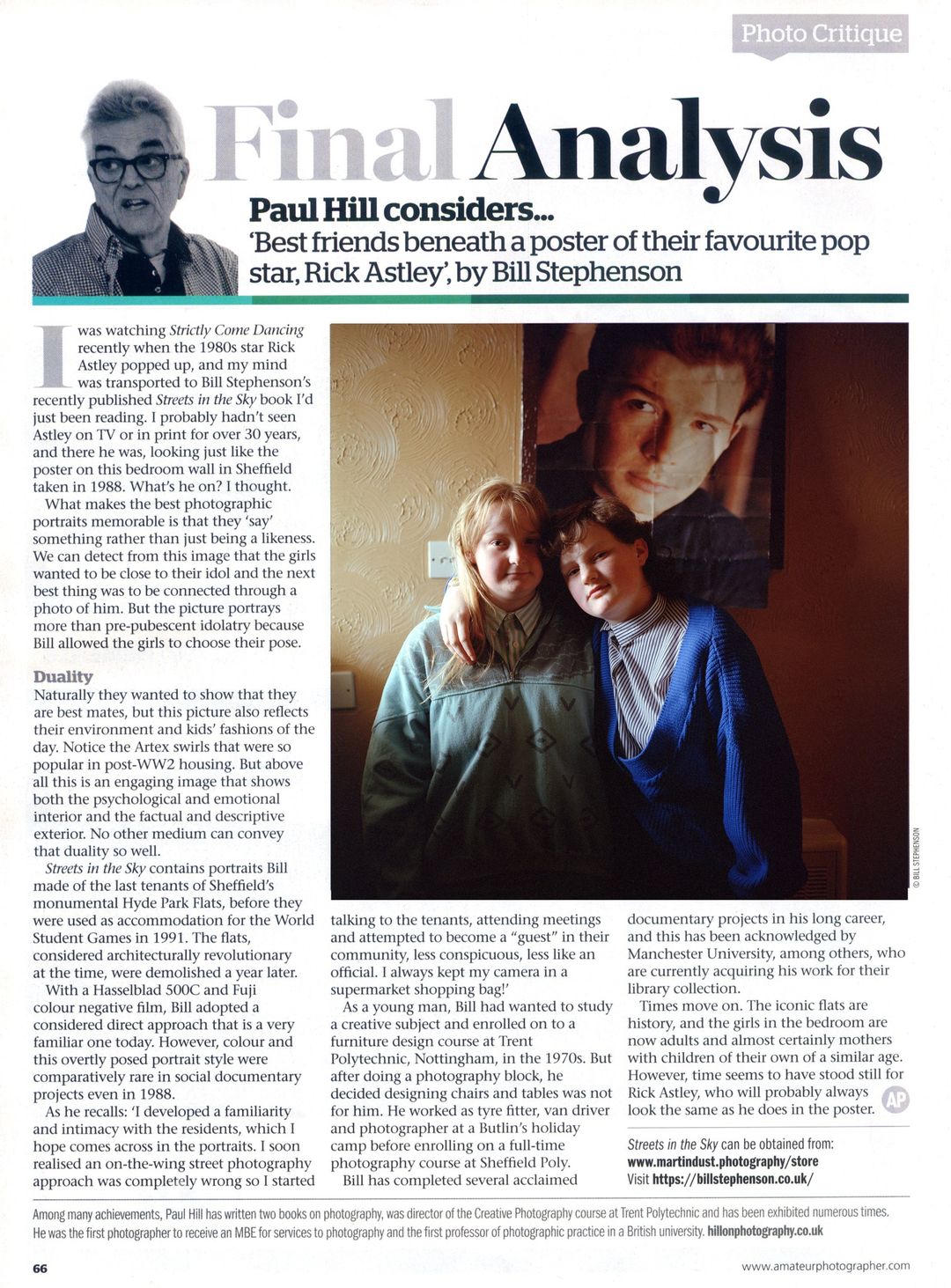
Feature story in Final Analysis from Amateur Photographer Magazine, February 2024.
Written by photographer, educator and author, Professor Paul Hill, MBE.
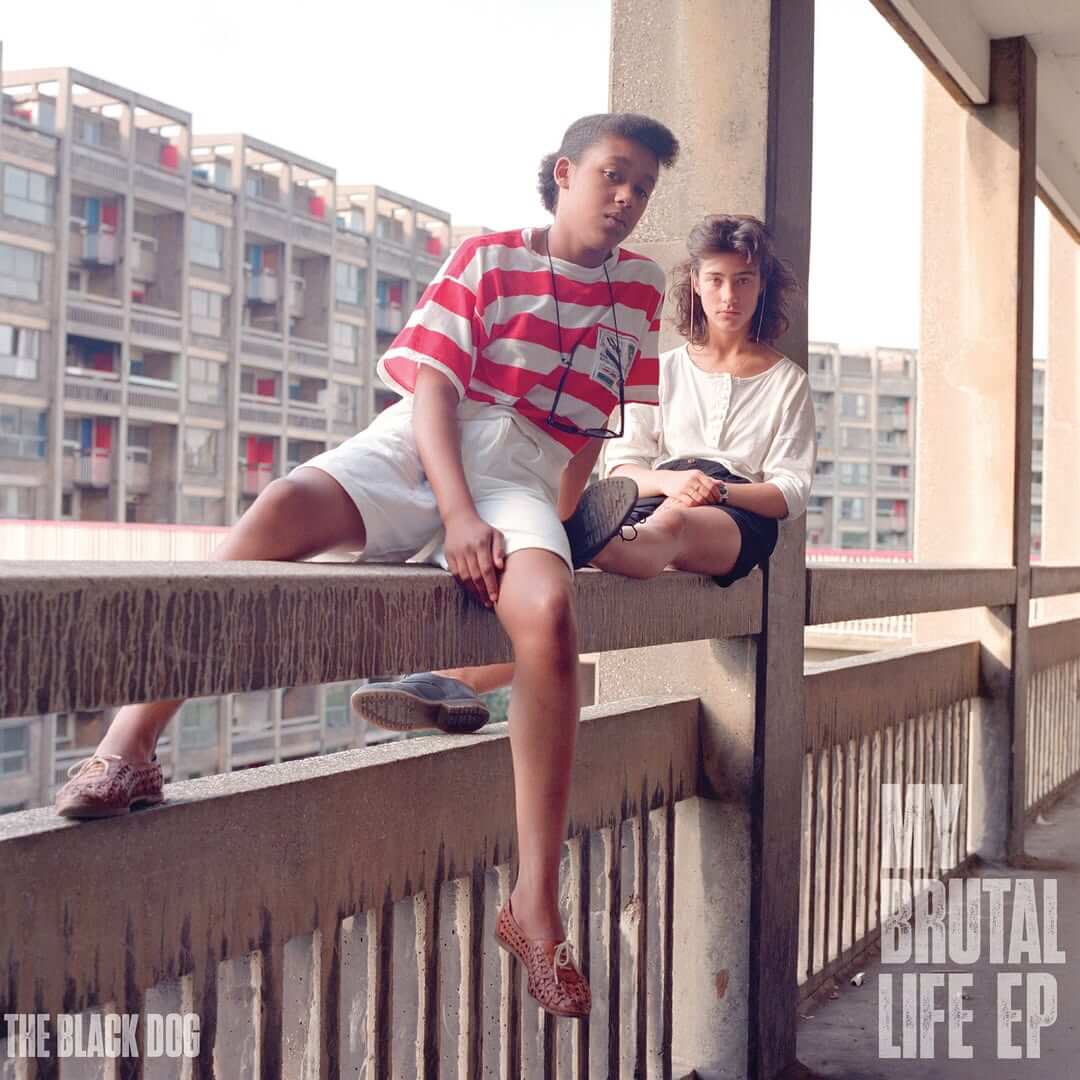
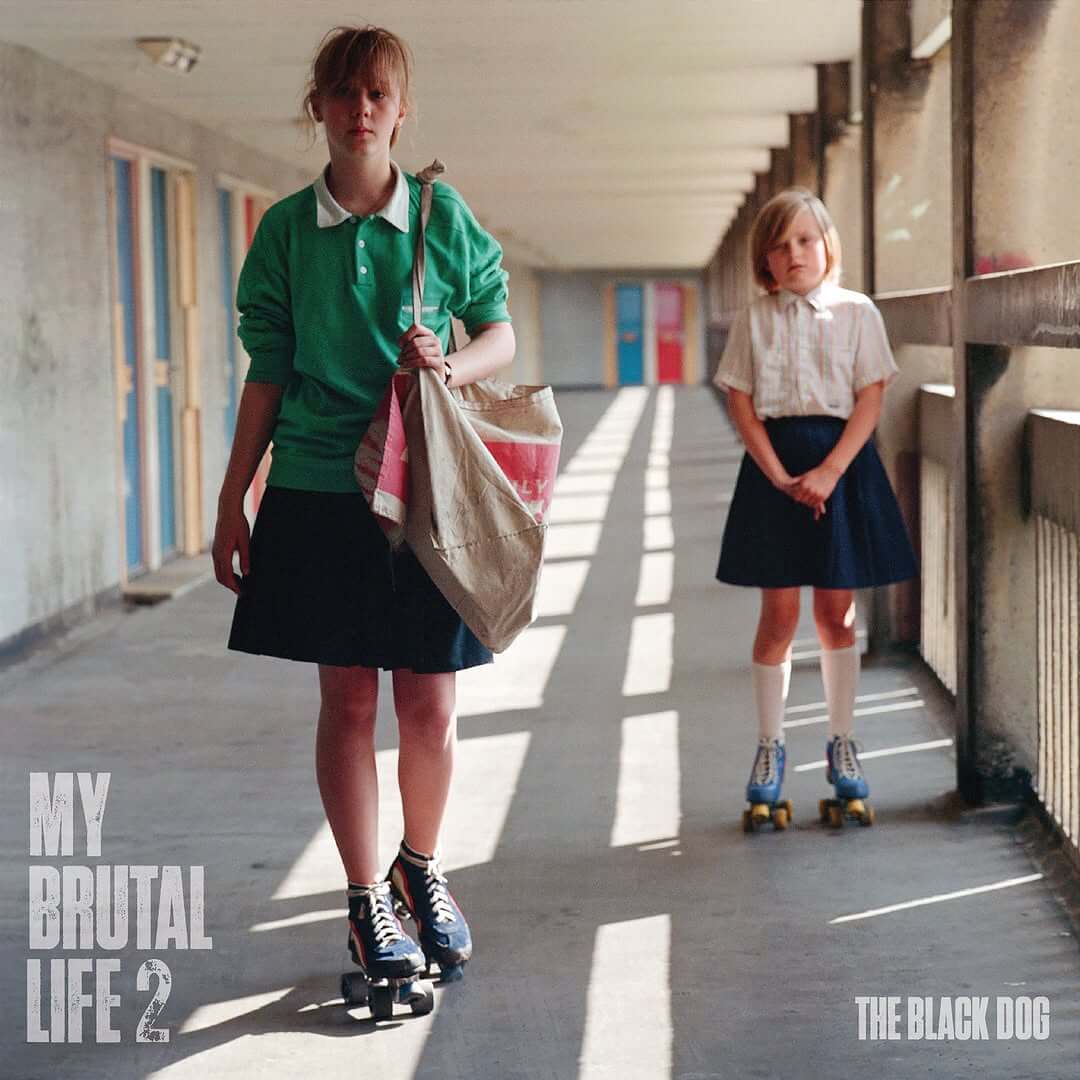
Photographs from this series have been used by pioneering techno musicians The Black Dog for their LP, EP, CD album covers and digital downloads for My Brutal Life 2.
Following up on their popular 2023 release “My Brutal Life”, My Brutal Life 2 continues their musical exploration of the human side of brutalist architecture and modern society.
Released April 2025.
Photographs from ‘Streets in the Sky‘ have been used in the following publications:
The Deck Access Housing Design Guide. A return to Streets in the Sky. Routledge. 2023.
In Depth: Urban Domesticities Today. Lars Müller publications, Zurich, Switzerland. 2025.
‘Streets in the Sky’
Portraits of the last residents at Hyde Park Flats, Sheffield. 1988.

[HP 001] Tony ‘the ton’ Greaves and Martin age 8, outside the ‘Pop In’ centre. The young kids at Hyde Park looked up to Tony as a role model and was nick named ‘the ton’ as they believed he could lift a ton weight.

[HP 002] Roller skating paper delivery girls Anita Cutts and Emma Guirham.

[HP 003] Jean, Eric Maybury and granddaughter Naomi age 6. Jean is the Secretary and Publicity Officer for the Hyde Park Tenants Association.

[HP 004] Donna Hargreaves and Carmen Bello both age 14, sit on a 4th storey concrete parapet. It was usual to see young people sunbathing on these balconies catching the last of the days sunshine.

[HP 005] Shirley Edwards, Sonja Marples both aged 17 and Kenneth Brissit age 14, near Manor Oaks Road at the rear of Hyde Park. The girls are posing as models. To the girls annoyance they being ‘trailed’ around the estate by Kenneth.
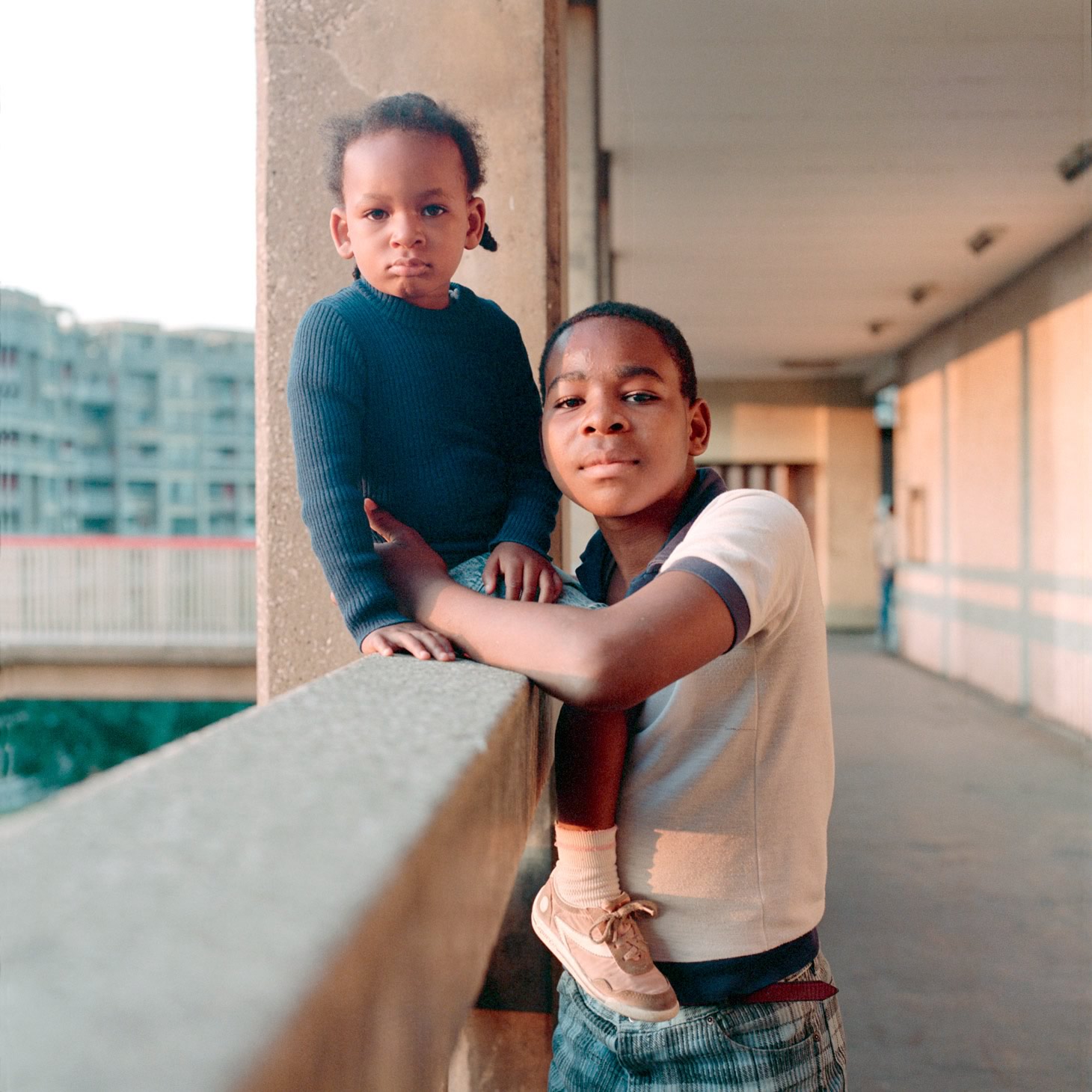
[HP 006] Kenneth Brisset age 14 and sister age 3, on a 4th storey parapet.

[HP 007] Couple on their way to the nearby canal basin carrying fishing nets, sandwiches, and pop for a picnic. Their three children cannot wait and are playing ahead of them.

[HP 008] Boys playing football during the summer holidays in St John’s C of E primary school playground.
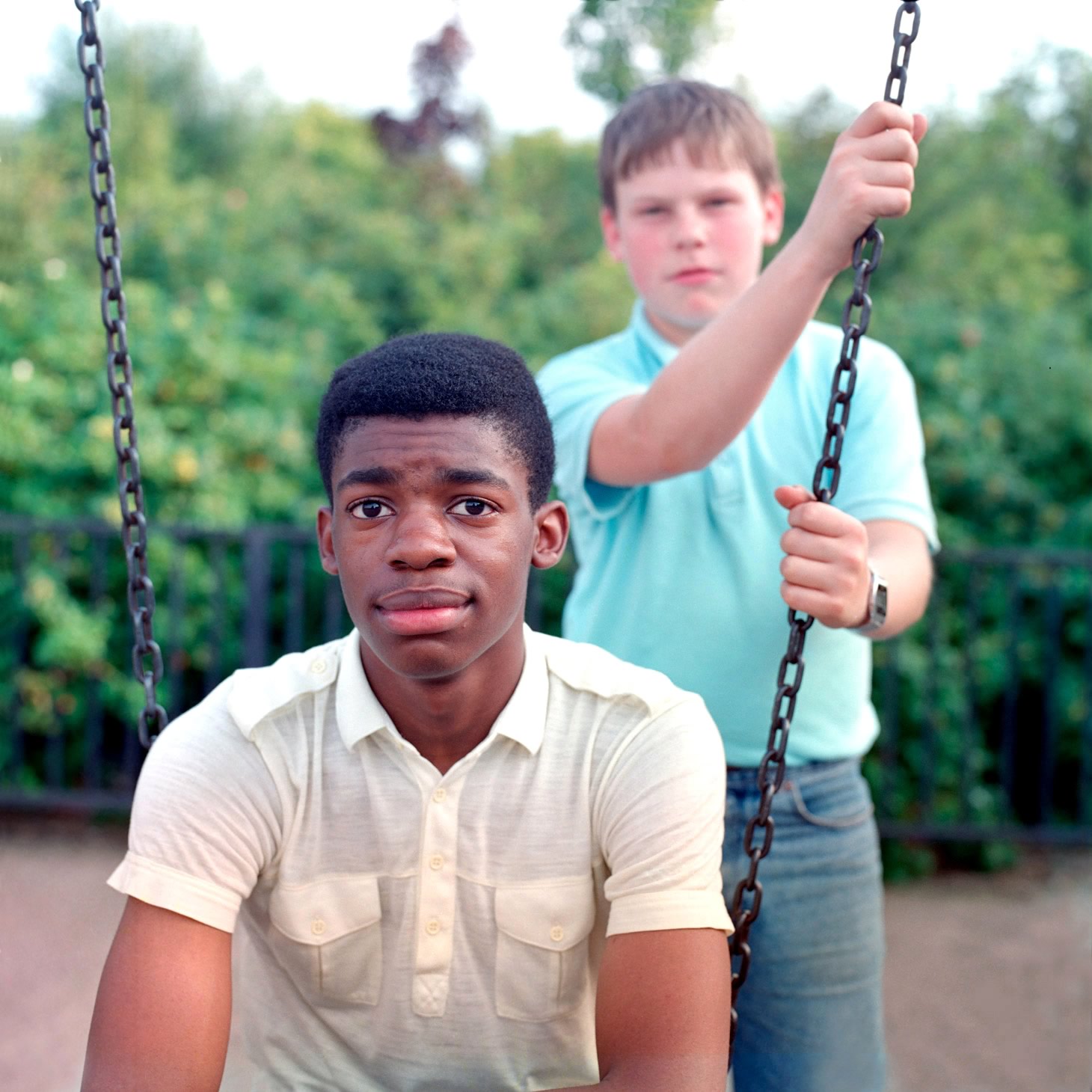
[HP 009] Leroy Edwards age 14 and friend in the children’s play area.
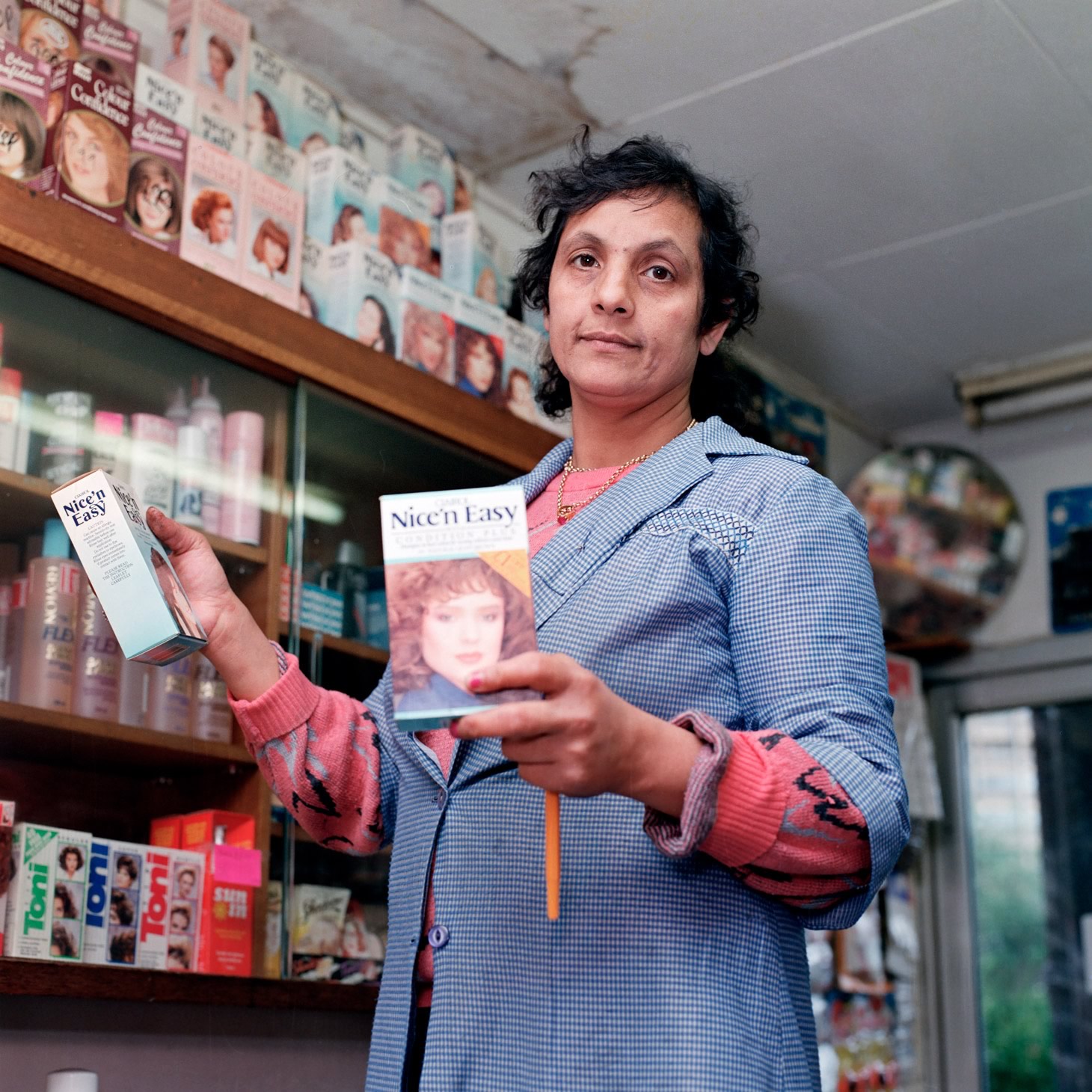
[HP 010] Sue, the owner of Sue’s shop. Despite the shop being regularly pilfered, she provided a life line to many tenants by providing ‘strap’ (derived from ‘strapped for cash’). Strap was a short term loan made to customers who cannot pay immediately. Defaulters names and their debt were eventually written on cards and placed in the shop window.

[HP 011] Sun burnt Nicky McQuillian age 4, buys a Cornetto at Sue’s shop.

[HP 012] Peter Marples on his BMX bike en route to Sue’s shop.
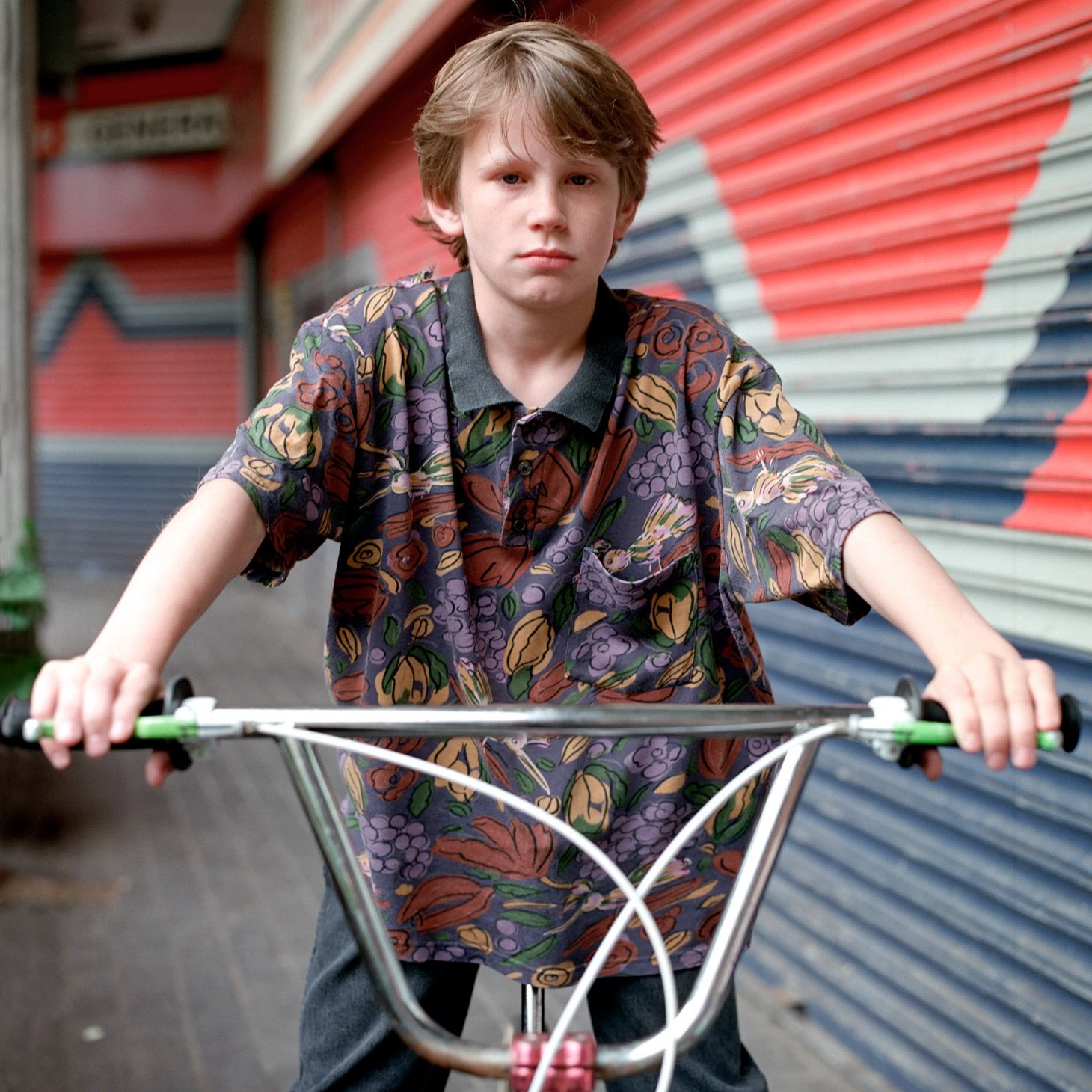
[HP 013] Peter Marples near Sue’s Shop.

[HP 014] Janet Casey age 18 and baby son Liam Kyle Perkins return from town.

[HP 015] Rachel Davies with bruised face after fighting with her sister.

[HP 016] Man walking his American Pitt Bull Terrier.

[HP 017] Woman on her way across ‘the bridge’ between tower blocks. She is carrying sweets, pop and biscuits to a children’s party.

[HP 018] Mrs Penny Dingley with her son Paul. Paul has lived his entire life at Hyde Park, he has special needs and is anxious having to leave his home.

[HP 019] Faisal and Sarah find romance by a service lift.

[HP 020] Manuel Bello playing with his dog near the ‘Pop In Centre’. Dogs are banned from the flats. Tenants faced being evicted if they did not give up their pets.

[HP 021] Sisters Nola and Noel near the Samuel Plimsoll pub.

[HP 022] Nola and Noel outside the Samuel Plimsol pub.

[HP 023] Tracy heads into Sheffield for a Saturday night out.
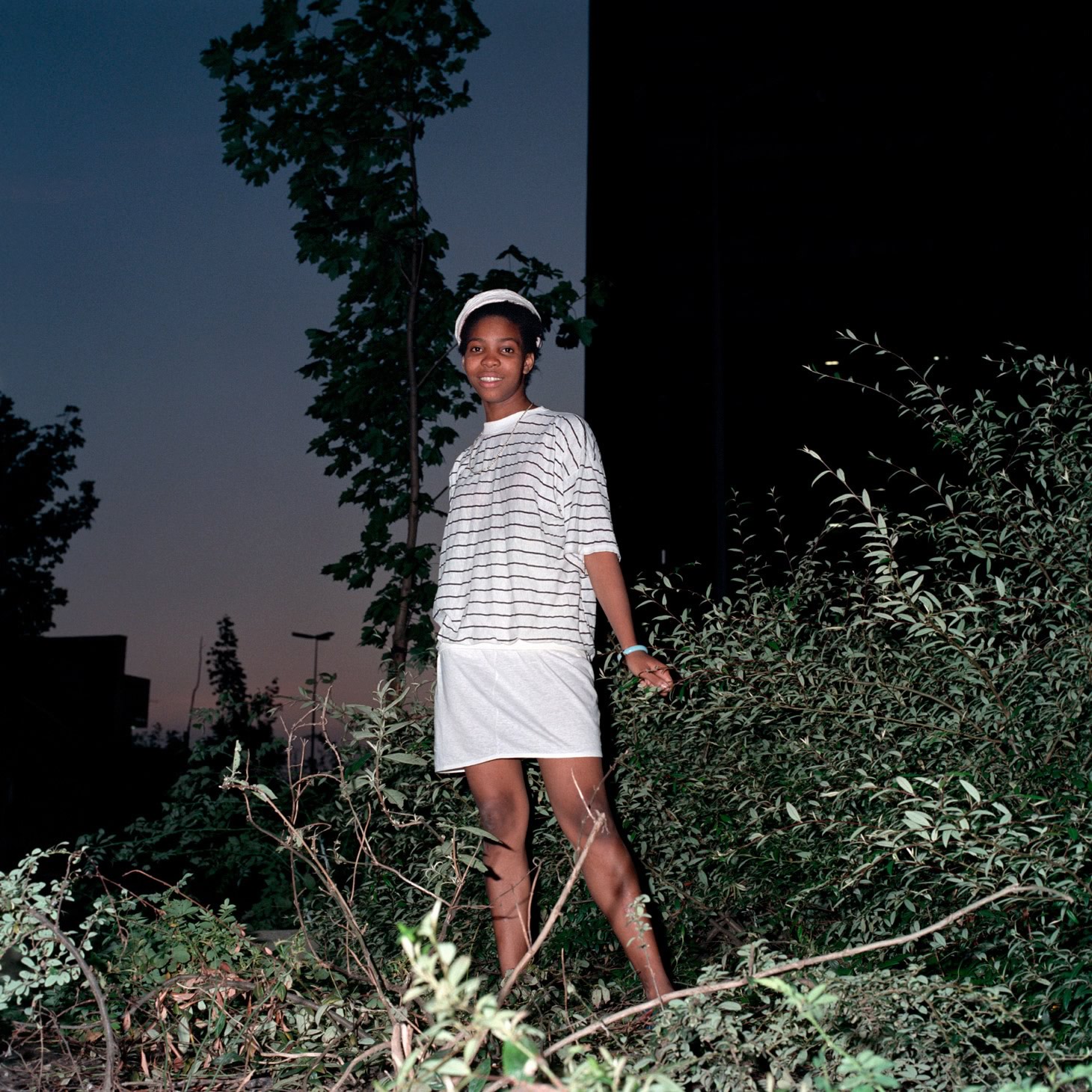
[HP 024] Girl playing out on a warm summer evening beneath a tower block.

[HP 025] Boy wearing his mothers makeup and wedding dress. He is on his way to a fancy dress contest being held at the youth club.

[HP 026] Dave Darbyshire is a redundant silver smith. Since losing his job he has suffered with depression, his German Shepherd dogs are his sole companions. He manages to keep them hidden from the authorities as dogs are banned from the estate, he faces eviction if they are discovered.

[HP 027] Mr Ackforth on his way to a pensioners’ lunch at the Community Centre.

[HP 028] Pam Stewart and her baby son Nathan Lee. Pam’s parents lived next door to her flat on Dacre Row, she can bang on the wall if she needs them.

[HP 029] Boys playing pool in the ‘unemployed club’ section of the youth club.
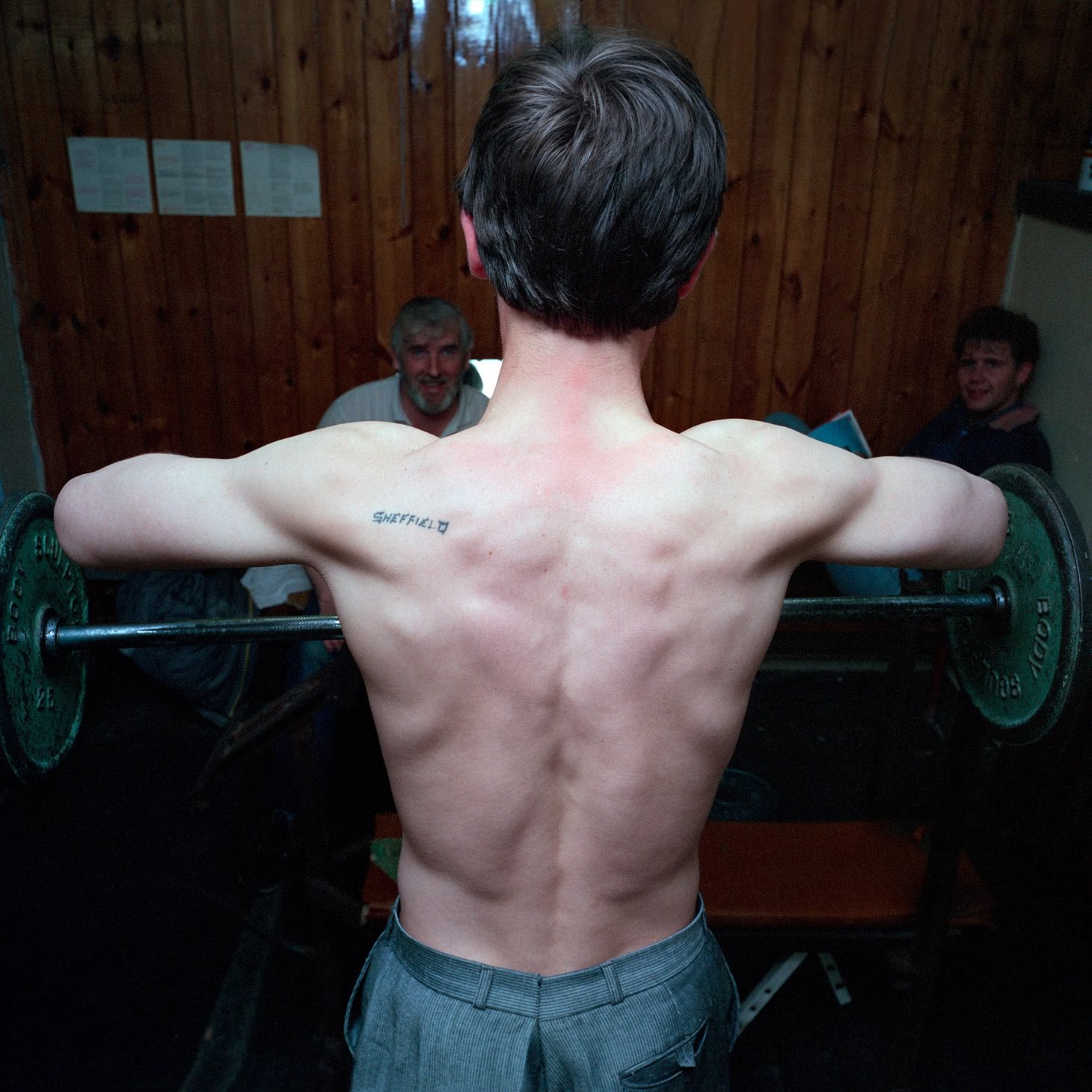
[HP 030] Simon Fairhurst weight training in the youth club. His trousers have been re-tailored to fit him. Simon’s shoulder tattoo say’s ‘Sheffield’.

[HP 031] Dean Haigh and David Jules both age 19, play fighting with a plastic knife in the youth club.

[HP 032] Tom, Anne, Pete Savage and Dean O’Brien in the cafe.

[HP 033] Girl returning home to her flat after shopping in town.

[HP 034] Mrs Rennie Barker from Rubens Row on her balcony.

[HP 035] Best friends beneath a poster of their favourite pop star Rick Astley.

[HP 036] Gavin Maybury age 9 and sister Alison age 14.

[HP 001] Tony ‘the ton’ Greaves and Martin age 8, outside the ‘Pop In’ centre. The young kids at Hyde Park looked up to Tony as a role model and was nick named ‘the ton’ as they believed he could lift a ton weight.
[HP 002] Roller skating paper delivery girls Anita Cutts and Emma Guirham.
[HP 003] Jean, Eric Maybury and granddaughter Naomi age 6. Jean is the Secretary and Publicity Officer for the Hyde Park Tenants Association.

[HP 004] Donna Hargreaves and Carmen Bello both age 14, sit on a 4th storey concrete parapet. It was usual to see young people sunbathing on these balconies catching the last of the days sunshine.
[HP 005] Shirley Edwards, Sonja Marples both aged 17 and Kenneth Brissit age 14, near Manor Oaks Road at the rear of Hyde Park. The girls are posing as models. To the girls annoyance they being ‘trailed’ around the estate by Kenneth.

[HP 006] Kenneth Brisset age 14 and sister age 3, on a 4th storey parapet.
[HP 007] Couple on their way to the nearby canal basin carrying fishing nets, sandwiches, and pop for a picnic. Their three children cannot wait and are playing ahead of them.
[HP 008] Boys playing football during the summer holidays in St John’s C of E primary school playground.

[HP 009] Leroy Edwards age 14 and friend in the children’s play area.

[HP 010] Sue, the owner of Sue’s shop. Despite the shop being regularly pilfered, she provided a life line to many tenants by providing ‘strap’ (derived from ‘strapped for cash’). Strap was a short term loan made to customers who cannot pay immediately. Defaulters names and their debt were eventually written on cards and placed in the shop window.
[HP 011] Sun burnt Nicky McQuillian age 4, buys a Cornetto at Sue’s shop.

[HP 012] Peter Marples on his BMX bike en route to Sue’s shop.

[HP 013] Peter Marples near Sue’s Shop.

[HP 014] Janet Casey age 18 and baby son Liam Kyle Perkins return from town.

[HP 015] Rachel Davies with bruised face after fighting with her sister.

[HP 016] Man walking his American Pitt Bull Terrier.

[HP 017] Woman on her way across ‘the bridge’ between tower blocks. She is carrying sweets, pop and biscuits to a children’s party.
[HP 018] Mrs Penny Dingley with her son Paul. Paul has lived his entire life at Hyde Park, he has special needs and is anxious having to leave his home.

[HP 019] Faisal and Sarah find romance by a service lift.

[HP 020] Manuel Bello playing with his dog near the ‘Pop In Centre’. Dogs are banned from the flats. Tenants faced being evicted if they did not give up their pets.

[HP 021] Sisters Nola and Noel near the Samuel Plimsoll pub.
[HP 022] Nola and Noel outside the Samuel Plimsol pub.
[HP 023] Tracy heads into Sheffield for a Saturday night out.

[HP 024] Girl playing out on a warm summer evening beneath a tower block.

[HP 025] Boy wearing his mothers makeup and wedding dress. He is on his way to a fancy dress contest being held at the youth club.

[HP 026] Dave Darbyshire is a redundant silver smith. Since losing his job he has suffered with depression, his German Shepherd dogs are his sole companions. He manages to keep them hidden from the authorities as dogs are banned from the estate, he faces eviction if they are discovered.

[HP 027] Mr Ackforth on his way to a pensioners’ lunch at the Community Centre.

[HP 028] Pam Stewart and her baby son Nathan Lee. Pam’s parents lived next door to her flat on Dacre Row, she can bang on the wall if she needs them.

[HP 029] Boys playing pool in the ‘unemployed club’ section of the youth club.

[HP 030] Simon Fairhurst weight training in the youth club. His trousers have been re-tailored to fit him. Simon’s shoulder tattoo say’s ‘Sheffield’.
[HP 031] Dean Haigh and David Jules both age 19, play fighting with a plastic knife in the youth club.
[HP 032] Tom, Anne, Pete Savage and Dean O’Brien in the cafe.
[HP 033] Girl returning home to her flat after shopping in town.
[HP 034] Mrs Rennie Barker from Rubens Row on her balcony.
[HP 035] Best friends beneath a poster of their favourite pop star Rick Astley.
[HP 036] Gavin Maybury age 9 and sister Alison age 14.



